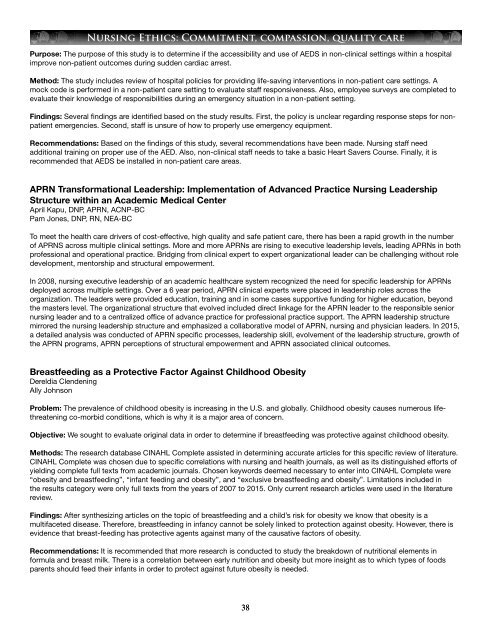Create successful ePaper yourself
Turn your PDF publications into a flip-book with our unique Google optimized e-Paper software.
Nursing Ethics: Commitment, compassion, quality care<br />
Purpose: The purpose of this study is to determine if the accessibility and use of AEDS in non-clinical settings within a hospital<br />
improve non-patient outcomes during sudden cardiac arrest.<br />
Method: The study includes review of hospital policies for providing life-saving interventions in non-patient care settings. A<br />
mock code is performed in a non-patient care setting to evaluate staff responsiveness. Also, employee surveys are completed to<br />
evaluate their knowledge of responsibilities during an emergency situation in a non-patient setting.<br />
Findings: Several findings are identified based on the study results. First, the policy is unclear regarding response steps for nonpatient<br />
emergencies. Second, staff is unsure of how to properly use emergency equipment.<br />
Recommendations: Based on the findings of this study, several recommendations have been made. Nursing staff need<br />
additional training on proper use of the AED. Also, non-clinical staff needs to take a basic Heart Savers Course. Finally, it is<br />
recommended that AEDS be installed in non-patient care areas.<br />
APRN Transformational Leadership: Implementation of Advanced Practice Nursing Leadership<br />
Structure within an Academic Medical Center<br />
April Kapu, DNP, APRN, ACNP-BC<br />
Pam Jones, DNP, RN, NEA-BC<br />
To meet the health care drivers of cost-effective, high quality and safe patient care, there has been a rapid growth in the number<br />
of APRNS across multiple clinical settings. More and more APRNs are rising to executive leadership levels, leading APRNs in both<br />
professional and operational practice. Bridging from clinical expert to expert organizational leader can be challenging without role<br />
development, mentorship and structural empowerment.<br />
In 2008, nursing executive leadership of an academic healthcare system recognized the need for specific leadership for APRNs<br />
deployed across multiple settings. Over a 6 year period, APRN clinical experts were placed in leadership roles across the<br />
organization. The leaders were provided education, training and in some cases supportive funding for higher education, beyond<br />
the masters level. The organizational structure that evolved included direct linkage for the APRN leader to the responsible senior<br />
nursing leader and to a centralized office of advance practice for professional practice support. The APRN leadership structure<br />
mirrored the nursing leadership structure and emphasized a collaborative model of APRN, nursing and physician leaders. In <strong>2015</strong>,<br />
a detailed analysis was conducted of APRN specific processes, leadership skill, evolvement of the leadership structure, growth of<br />
the APRN programs, APRN perceptions of structural empowerment and APRN associated clinical outcomes.<br />
Breastfeeding as a Protective Factor Against Childhood Obesity<br />
Dereldia Clendening<br />
Ally Johnson<br />
Problem: The prevalence of childhood obesity is increasing in the U.S. and globally. Childhood obesity causes numerous lifethreatening<br />
co-morbid conditions, which is why it is a major area of concern.<br />
Objective: We sought to evaluate original data in order to determine if breastfeeding was protective against childhood obesity.<br />
Methods: The research database CINAHL Complete assisted in determining accurate articles for this specific review of literature.<br />
CINAHL Complete was chosen due to specific correlations with nursing and health journals, as well as its distinguished efforts of<br />
yielding complete full texts from academic journals. Chosen keywords deemed necessary to enter into CINAHL Complete were<br />
“obesity and breastfeeding”, “infant feeding and obesity”, and “exclusive breastfeeding and obesity”. Limitations included in<br />
the results category were only full texts from the years of 2007 to <strong>2015</strong>. Only current research articles were used in the literature<br />
review.<br />
Findings: After synthesizing articles on the topic of breastfeeding and a child’s risk for obesity we know that obesity is a<br />
multifaceted disease. Therefore, breastfeeding in infancy cannot be solely linked to protection against obesity. However, there is<br />
evidence that breast-feeding has protective agents against many of the causative factors of obesity.<br />
Recommendations: It is recommended that more research is conducted to study the breakdown of nutritional elements in<br />
formula and breast milk. There is a correlation between early nutrition and obesity but more insight as to which types of foods<br />
parents should feed their infants in order to protect against future obesity is needed.<br />
38

















